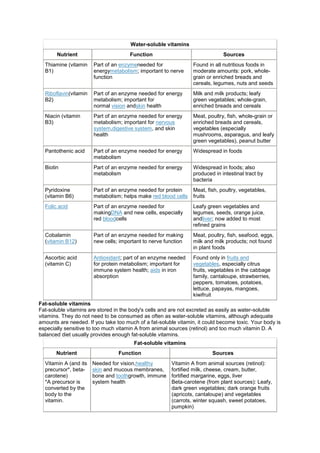Vitamins
- 1. Water-soluble vitamins Nutrient Function Sources Thiamine (vitamin B1) Part of an enzymeneeded for energymetabolism; important to nerve function Found in all nutritious foods in moderate amounts: pork, whole- grain or enriched breads and cereals, legumes, nuts and seeds Riboflavin(vitamin B2) Part of an enzyme needed for energy metabolism; important for normal vision andskin health Milk and milk products; leafy green vegetables; whole-grain, enriched breads and cereals Niacin (vitamin B3) Part of an enzyme needed for energy metabolism; important for nervous system,digestive system, and skin health Meat, poultry, fish, whole-grain or enriched breads and cereals, vegetables (especially mushrooms, asparagus, and leafy green vegetables), peanut butter Pantothenic acid Part of an enzyme needed for energy metabolism Widespread in foods Biotin Part of an enzyme needed for energy metabolism Widespread in foods; also produced in intestinal tract by bacteria Pyridoxine (vitamin B6) Part of an enzyme needed for protein metabolism; helps make red blood cells Meat, fish, poultry, vegetables, fruits Folic acid Part of an enzyme needed for makingDNA and new cells, especially red bloodcells Leafy green vegetables and legumes, seeds, orange juice, andliver; now added to most refined grains Cobalamin (vitamin B12) Part of an enzyme needed for making new cells; important to nerve function Meat, poultry, fish, seafood, eggs, milk and milk products; not found in plant foods Ascorbic acid (vitamin C) Antioxidant; part of an enzyme needed for protein metabolism; important for immune system health; aids in iron absorption Found only in fruits and vegetables, especially citrus fruits, vegetables in the cabbage family, cantaloupe, strawberries, peppers, tomatoes, potatoes, lettuce, papayas, mangoes, kiwifruit Fat-soluble vitamins Fat-soluble vitamins are stored in the body's cells and are not excreted as easily as water-soluble vitamins. They do not need to be consumed as often as water-soluble vitamins, although adequate amounts are needed. If you take too much of a fat-soluble vitamin, it could become toxic. Your body is especially sensitive to too much vitamin A from animal sources (retinol) and too much vitamin D. A balanced diet usually provides enough fat-soluble vitamins. Fat-soluble vitamins Nutrient Function Sources Vitamin A (and its precursor*, beta- carotene) *A precursor is converted by the body to the vitamin. Needed for vision,healthy skin and mucous membranes, bone and toothgrowth, immune system health Vitamin A from animal sources (retinol): fortified milk, cheese, cream, butter, fortified margarine, eggs, liver Beta-carotene (from plant sources): Leafy, dark green vegetables; dark orange fruits (apricots, cantaloupe) and vegetables (carrots, winter squash, sweet potatoes, pumpkin)
- 2. Vitamin D Needed for proper absorption of calcium; stored in bones Egg yolks, liver, fatty fish, fortified milk, fortified margarine. When exposed to sunlight, the skin can make vitamin D. Vitamin E Antioxidant; protects cell walls Polyunsaturated plant oils (soybean, corn, cottonseed, safflower); leafy green vegetables; wheat germ; whole-grain products; liver; egg yolks; nuts and seeds Vitamin K Needed for proper blood clotting Leafy green vegetables and vegetables in the cabbage family; milk; also produced in intestinal tract by bacteria


